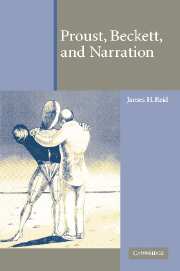Book contents
- Frontmatter
- Contents
- List of abbreviations
- Introduction
- 1 Remembering forgetting: Le Drame du coucher
- 2 Impressions, the instant of artistic consciousness, and social history
- 3 Lying, irony, and power: Proust's deceptive allegories
- 4 Proust's forgetful ironies
- 5 Molloy's Way: The parody of allegory
- 6 Moran's Way: The forgetful spiral of irony
- 7 Malone Dies and the impossibility of not saying I
- 8 The Unnamable: The death of the ironical self and the return of history
- Notes
- Bibliography
- Index
6 - Moran's Way: The forgetful spiral of irony
Published online by Cambridge University Press: 22 September 2009
- Frontmatter
- Contents
- List of abbreviations
- Introduction
- 1 Remembering forgetting: Le Drame du coucher
- 2 Impressions, the instant of artistic consciousness, and social history
- 3 Lying, irony, and power: Proust's deceptive allegories
- 4 Proust's forgetful ironies
- 5 Molloy's Way: The parody of allegory
- 6 Moran's Way: The forgetful spiral of irony
- 7 Malone Dies and the impossibility of not saying I
- 8 The Unnamable: The death of the ironical self and the return of history
- Notes
- Bibliography
- Index
Summary
Molloy's seemingly allegorical narrator, who initially pretends to seek out mother and self, tries to take refuge from allegory in transhistorical irony of irony, and parody of parody, which he already found in Proust. However, this very attempt to be fully ironical produces a repetition of allegory. Molloy narrator thus traces a failed attempt to transform the allegory of his past search for, and deconstruction of, self into a pure present of irony. In the second half of Molloy, Moran narrator, who imagines himself to be purely ironical, recounts the failed process of transforming his past and present ironical selves into an allegorical narration like the one that Molloy initially appears to adopt.
Moran narrator has no interest in Proust's remembering narrator. Rather, like Proust's writing narrator, he tries to adopt a purely ironical stance towards allegory. Like Proust and his writing narrator, Moran is an insomniac who writes during the night: “It is midnight. The rain is beating on the windows … I can't sleep. My lamp … will last till morning … My report will be long … I remember the day I received the order to see about Molloy …” (TN, 92). Moran narrator's reference to his present writing of a report on his past investigation of Molloy creates the impression that he, unlike Molloy, can voluntarily remember the past.
- Type
- Chapter
- Information
- Proust, Beckett, and Narration , pp. 99 - 116Publisher: Cambridge University PressPrint publication year: 2003



